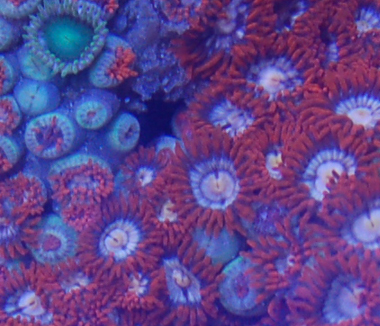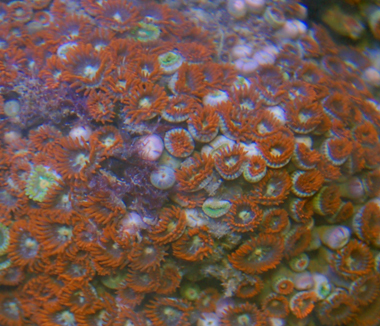|
Zoanthus sansibaricus - Vietnamese Zoanthids
Dr. Reimer Fills Us in on Our Own Product Dr. James Reimer, a friend of Blue Zoo News (be sure to check out the interview with him in the archives), is a zoanthid specialist who took a look at some photos of the amazing Vietnamese zoanthids ("Vietnamese ultra colored zoanthids" is how we have them listed on the site) we recently received. His initial response was “Sweet pix!” While I agree, I was hoping for a little more, and, of course, Reimer delivered. “They look a lot like Z. sansibaricus we have here in Japan, with maybe a few colonies of Z. vietnamensis,” he told us, but, of course, with zoanthids it’s really hard to say from simply looking at a picture.
The trouble with zonthid identification—and the reason that most are
sold in the marine aquarium hobby as simply Zoanthus spp.—is that no clear method for identifying species within the genus has yet been established. Why is this? It has to do with morphological plasticity, or, in laymen’s terms, the fact that the same species of zoanthid often appears in many, many different shapes and colors. This is one reason marine scientists with a penchant for zoanthids have started looking at other methods of species identification in an effort to set the taxonomical record straight and shed new light on these amazing animals.
 |
| "Vietnamese ultra colored zoanthids" Zoanthus sansibaricus? |
"Genetic methods of identifying zoanthids are a potentially useful tool,” says Reimer, who has spent a fair bit of time using molecular biology to discern relationships between individual organisms. “If recent genetic studies are any indication,” Reimer says, “single species of Zoanthus may encompass a wide variety of morphological types, and the true number of species may be grossly overestimated.” What?! So we are correct in calling them all Zoanthus spp.?
Reimer has spent a lot of time over the last couple of years looking at gene sequence data, and he has concluded that, in fact, several previously identified, individual Zoanthus species from the Pacific (e.g., Z. gnophodes, Z. erythrochloros and Z. pacificus) are really all the same species—Z. sansibaricus—with wildly diverse morphotypes. To further compound things, Z. sansibaricus may prove itself to be a member of another, even earlier described species, but tests are ongoing.
“Zoanthus sansibaricus has many different morphotypes,” Reimer says, “so many, in fact, that this species consists of what were previously thought to be at least four species.” Reimer offers a group of 13 pictures of very different looking zoanthids. “DNA has confirmed that all of these different morphs are in fact one species.” Reimer tells us he has seen as many as 30 morphotypes at one location!
 |
| "Vietnamese ultra colored zoanthids" Zoanthus sansibaricus? |
In other exciting and related news from Reimer’s lab, Reimer and his team have identified that the Caribbean zoanthid species Z. pulchellus is, in fact, very closely related to Z. sansibaricus despite the fact that these animals are from completely different zoogeographical regions. It is likely that these two species were once the same species and only evolved into their present genetic make-up as a result of the western Atlantic and the Pacific being separated by the zoogeographical boundary known as Panama.
Either way you look at it, Z. sansibaricus or not, these zoanthids are, in the words of Blue Zoo's own Mark Martin, "by far the best, brightest and most densely covered zoanthids I have ever seen."
Published 25 August 2008. © Blue Zoo Aquatics
|